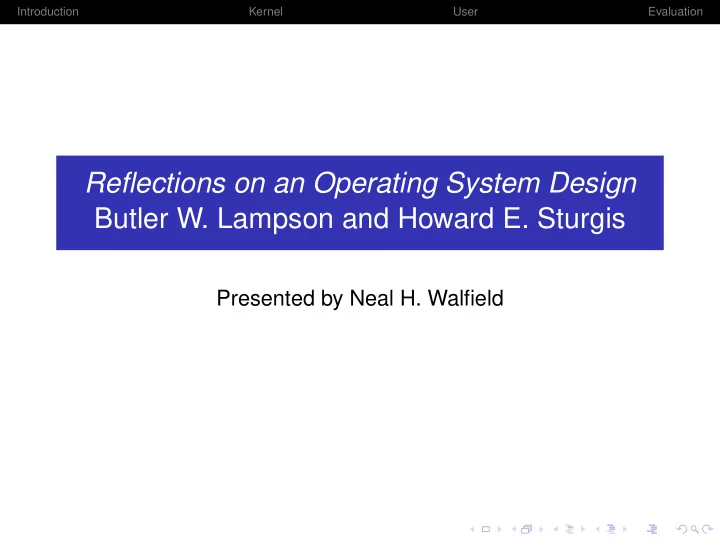

Introduction Kernel User Evaluation Reflections on an Operating System Design Butler W. Lampson and Howard E. Sturgis Presented by Neal H. Walfield
Introduction Kernel User Evaluation Cal System ◮ General purpose OS ◮ 200 users ◮ Classes of Applications ◮ Editing ◮ “Typical Fortran batch jobs” ◮ Large batch jobs ◮ Legacy support
Introduction Kernel User Evaluation Structure ◮ Capabilities ◮ Objects ◮ Domains ◮ Layers ◮ Abstract machine / New architecture / Virtual Machine ◮ Unprivileged ◮ No reliance on later layers ◮ Explicit accounting
Introduction Kernel User Evaluation Isolation ◮ Domains ◮ Protection from others ◮ Confined ◮ Controlled breaching via messaging
Introduction Kernel User Evaluation First Protection Layer ◮ Microkernel ◮ 8 objects ◮ No reliance on disk
Introduction Kernel User Evaluation Kernel Objects ◮ Kernel files - Mach Memory Object ◮ Event channels - Inter-process signalling (fixed size queue) ◮ Allocation blocks - Memory and CPU quota ◮ C-lists ◮ Capabilities ◮ Labels - Names a domain ◮ Processes - Hierarchy of domains ◮ Operations - Authority to invoke a domain
Introduction Kernel User Evaluation Capabilities ◮ Name objects ◮ Data: < type , rights , value > ◮ value : object pointer or word ◮ As object pointer: < unique name , index > ◮ Indexes Master Object Table (MOT) ◮ Name stored in MOT entry ◮ O(1) revoke ◮ O(1) relocation
Introduction Kernel User Evaluation Processes ◮ Virtual machine ◮ Contain tree of domains ◮ Call stack - no reply capability
Introduction Kernel User Evaluation Operations ◮ Realize user-objects ◮ Sealed closures ◮ Authority to transfer control to another domain
Introduction Kernel User Evaluation Extensibility ◮ Invalid operations return abnormal ly ◮ Kernel chains to next level in operation ◮ Cost of abstraction is zero ◮ Not for overriding functionality
Introduction Kernel User Evaluation Disk Files ◮ Extend kernel files to support paging ◮ Invocation only goes to disk file when kernel file returns abnormally
Introduction Kernel User Evaluation Directories ◮ Symbolic name to user capability ◮ Access control lists ◮ Directory is trusted by user?
Introduction Kernel User Evaluation Accountability ◮ Reduction in sharing ◮ Difficult to attribute, e.g., automatic ◮ Lots of unnecessary paging
Introduction Kernel User Evaluation Object Paging ◮ Kernel objects not paged: ◮ No reliance on disk (transparent paging) ◮ Data integrity 1 (user pagers) ◮ Kernel resources are sparse 1 User-level checkpointing through exportable kernel state: Tullmann, et al., 1996
Introduction Kernel User Evaluation Duplicity ◮ Process ≈ Domains ◮ Event Channels ≈ Operations ◮ Motivated by performance concerns ◮ Unnecessary
Introduction Kernel User Evaluation Negative Results ◮ 2–3 iterations for new ideas to be implemented efficiently ◮ Don’t ignore design flaws ◮ An OS is more than a kernel
Introduction Kernel User Evaluation Positive Results ◮ Layering ◮ Simplification ◮ Reliability ◮ Capabilities ◮ Consistent and uniform naming ◮ Consistent and uniform access control ◮ Devices as processes
Introduction Kernel User Evaluation My Observations ◮ Little focus on security ◮ Access control does not rely on delegation ◮ System not persistent
Introduction Kernel User Evaluation Questions ◮ Domain Labels: identify a service in any process? ◮ How do types work?
Recommend
More recommend